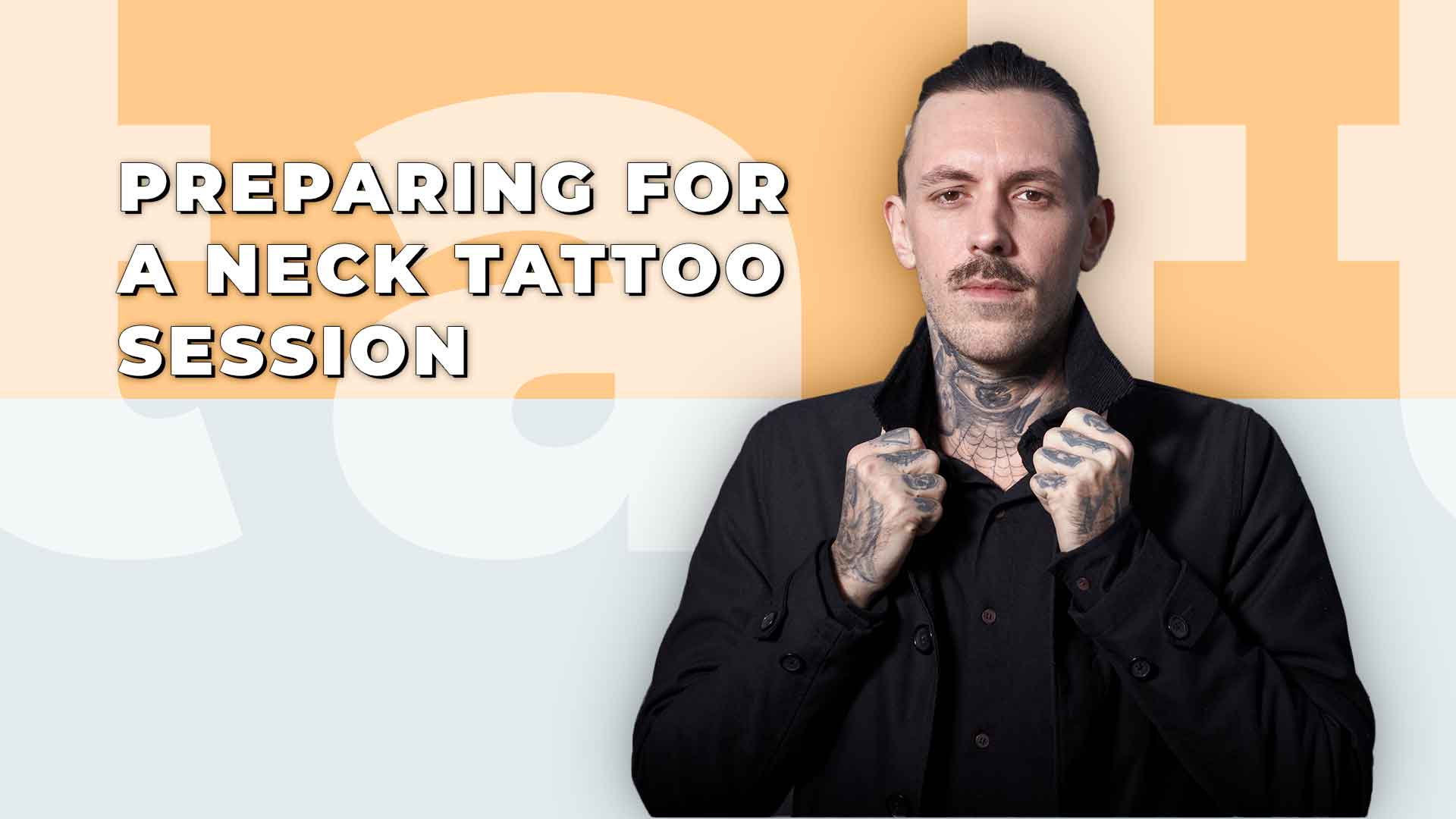In recent years, neck tattoos have become very popular. But people often ask how much they hurt. The sensitivity of the skin in this area makes neck tattoos painful. This guide will explain why neck tattoos hurt, how to make them less painful, and the healing process. If you’re thinking about getting a neck tattoo or curious about the pain, this article has what you need.
Factors Affecting Neck Tattoo Pain

The pain from a neck tattoo can change based on different things. One of the primary factors is the location of the tattoo on the neck. The front of the neck is very sensitive because the skin is thin, has many nerves, and has a lot of muscle. Hence, front neck tattoos cause the most pain.
In contrast, people consider the side of the neck one of the least painful areas for a tattoo. Fewer nerves in this region contribute to a lower level of discomfort. Everyone has a different pain tolerance, so their experiences may be different.
Another significant factor is the design of the tattoo itself. Tattoos with thin lines hurt less than ones that need lots of filling or shading. If you’re new to neck tattoos or don’t handle pain well, starting with a smaller design is best. This way, you can see how comfortable you are before getting a bigger, more detailed tattoo.
Choosing a Tattoo Studio and Artist
Choose a good studio and skilled artist to have a safe and comfortable tattoo experience. Here are some factors to consider when choosing a tattoo studio:
- Research and read reviews:
Look for studios with positive reviews and a good reputation. Online platforms and social media can provide valuable insights into previous clients’ experiences.
- Visit the studio:
Schedule a visit before your appointment to assess its cleanliness, professionalism, and atmosphere. Ensure that the studio follows proper hygiene practices and uses sterile equipment.
- Check the artist’s portfolio:
Review the artist’s portfolio to check their style and skill level. Look for artists who specialize in the type of tattoo you want and have experience working on the neck area.
- Consultation with the artist:
Make an appointment with your chosen artist. Talk to them about your ideas, pain concerns, and questions. Before tattooing starts, make sure you both understand each other.
Preparing for a Neck Tattoo Session

To ensure a smooth and comfortable neck tattoo session, prepare yourself beforehand. Here are some tips to consider:
- Get a good night’s sleep:
Make sure to get a good night’s sleep before your tattoo appointment. This will help you be ready both mentally and physically for the session.
- Eat a nutritious meal:
Eat a balanced meal a few hours beforehand to keep your energy up during your tattoo appointment.
- Dress comfortably:
Opt for loose-fitting clothing that allows easy access to the tattooed area. This will reduce discomfort and make your tattoo artist’s work easier.
- Communicate with your artist:
Before your tattoo session, talk to your artist about any worries or pain limits. To have a good experience, make sure you communicate and understand each other.
What to Expect During a Neck Tattooing Session
During your neck tattoo session, feeling excitement and nervousness is natural. Here’s what you can generally expect during the process:
- Consultation:
Your tattoo artist will talk with you to decide on the design, where it goes, and how big it is. They will also talk about any pain or discomfort in the neck.
Read also: Best Tattoo Locations for Skinny People.
- Preparation:
The artist will clean and shave the tattoo area to ensure a clean and smooth canvas for the tattoo.
- Stenciling:
Using transfer paper, the artist will create a stencil or transfer the design onto your neck. Before the tattooing starts, preview the placement and make any adjustments you need.
- Tattooing:
The artist will use a tattoo machine with sterilized needles to apply the ink to your skin. The sensation can range from a scratching feeling to a mild stinging sensation.
- Breaks:
Your artist may offer short breaks during the session to allow you to rest and manage any discomfort.
- Aftercare instructions:
Once the tattoo is complete, your artist will provide detailed aftercare instructions. It’s important to follow these instructions to ensure proper healing.
Neck Tattoo Aftercare and Healing Process
Taking care of your neck tattoo is important to help it heal well and avoid problems. Here are some essential steps to follow during the healing process:
- Keep the tattoo clean:
Wash the tattooed area with mild soap and warm water. To help your skin heal, don’t scrub or use strong cleansers that can irritate it.
- Apply a thin layer of aftercare ointment:
Use a recommended ointment like A+D or a tattoo product to take care of your tattoo. This will keep your tattoo moisturized and protected. Be sure to apply only a thin layer to avoid suffocating the skin.
- Avoid excessive moisture and friction:
Avoid getting it wet to help your tattoo heal, like in pools or baths. Also, don’t wear tight clothes or accessories that can rub the tattoo and make it irritated.
- Protect from the sun:
Keep the tattooed area out of direct sunlight and apply sunscreen with a high SPF when exposed to the sun. UV rays can fade the tattoo and cause complications during healing.
- Avoid picking or scratching:
It’s important not to scratch or pick at the tattoo because it can get infected and ruin the way it looks.
- Follow the artist’s instructions:
Your tattoo artist will provide specific aftercare instructions tailored to your tattoo. Follow their advice to ensure proper healing and long-lasting results.
Tattoo Healing Time for Neck Tattoos
The time it takes for neck tattoos to heal can vary. The size and complexity of the design, a person’s healing ability, and proper care are factors. A neck tattoo takes around 2-4 weeks to heal completely.
The tattooed area might feel sore, puffy, and itchy at the beginning of healing. It’s important not to scratch or pick at the tattoo, as this can lead to infection or scarring. To help your tattoo heal well and avoid problems, follow the aftercare instructions from your artist.
Tips for Minimizing Neck Tattoo Pain
Getting a neck tattoo can be painful, but you can use strategies to reduce discomfort. Here are some tips to consider before your tattoo session:
- Choose Wisely
Opt for a design that suits your pain tolerance. Small tattoos hurt less than big ones because they need less filling and shading. If you start with a smaller tattoo, you can see how much pain you can handle. This helps you decide if you want a bigger tattoo later.
- Stay Sober
Avoid consuming alcohol or taking painkillers before your tattoo session. While these substances may dull the pain temporarily, they can thin the blood and increase bleeding, potentially affecting the quality of the tattoo. Energy drinks should also be avoided as they can increase sensitivity.
- Hydrate Well
Proper hydration is crucial for preparing your skin before a tattoo. Drinking lots of water helps your skin absorb ink better, leading to improved results. Make sure to hydrate well in the days leading up to your appointment.
- Eat a Nutritious Meal
Eating a balanced meal before your tattoo session is essential to prevent fainting or dizziness. Low blood sugar levels can contribute to discomfort during the tattooing process. Ensure you have a good meal a few hours before your appointment to keep your energy levels up.
- Take Breaks
Communicate with your tattoo artist and take short breaks during the session if needed. Walking around, stretching, and drinking water can help alleviate discomfort and provide temporary relief. However, taking too many breaks may prolong the overall process and lead to increased swelling, so it’s important to find a balance.
- Consider Numbing Products
If you’re particularly concerned about pain, numbing creams can be a helpful option. While their effectiveness varies from person to person, they can provide temporary relief. Zensa Numbing Cream is a popular choice for tattoo enthusiasts. It contains the highest amount of Lidocaine allowed for over-the-counter use. Before your tattoo session, apply the cream for a more comfortable experience.
Do Back Neck Tattoos Hurt?

Getting a tattoo on the back of your neck hurts less than on the front. The skin on the back of the neck is thinner, but there is more fat and muscle in this area. This extra padding helps cushion it and makes it less sensitive. People with neck tattoos at the back say the neck’s lower part is the least painful. It’s near the shoulders and spine.
Back neck tattoos are usually less painful, but everyone’s pain tolerance is different.
Check Out: Fullback Tattoo Ideas!
Pain Relief Methods During the Tattoo Session
Getting a neck tattoo will always hurt, but there are ways to lessen the pain. Here are some common techniques used by tattoo artists:
- Distraction techniques:
Talking or listening to music can distract from pain and make it easier to handle.
- Deep breathing and relaxation exercises:
Try deep breathing and relaxation techniques to calm your nerves and feel less pain.
- Topical anesthetics:
Some tattoo artists might use creams or sprays to numb the skin and reduce pain. Discuss this option with your artist beforehand to see if it is available.
Remember, communication with your tattoo artist is key throughout the session. They can provide guidance and support to help manage the pain and ensure comfort.
The Final Thought
Neck tattoos can be a bold and expressive form of body art but come with a fair amount of pain. The skin on the neck is sensitive, so getting a tattoo there can be uncomfortable, especially on the front. You can reduce discomfort and heal by preparing, managing pain, and taking care.
Remember to choose a reputable tattoo studio and artist, communicate your pain concerns and preferences, and follow all aftercare instructions provided. By taking these steps, you’ll be well-prepared for your neck tattoo journey and can confidently embrace the artistry and individuality it represents.

